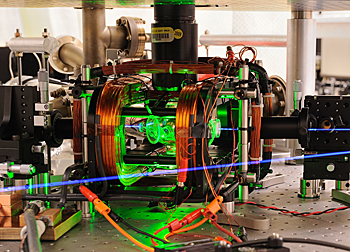National Institute of Standards and Technology (NIST) researchers have created a link between two separated ions’ quantum properties by manipulating the ions with microwaves rather than using laser beams.
This may lead to a replacement "laser park”, a room-sized quantum computing, with miniaturized microwave technology same as the one utilized in smart phones.
 Composite photo of microwave apparatus used in NIST quantum computing experiments. A pair of ions (electrically charged atoms) are trapped by electric fields and manipulated with microwaves inside a glass chamber at the center of the apparatus. The chamber is illuminated by a green light-emitting diode for visual effect. An ultraviolet laser beam used to cool the ions and detect their quantum state is colorized to appear blue
Composite photo of microwave apparatus used in NIST quantum computing experiments. A pair of ions (electrically charged atoms) are trapped by electric fields and manipulated with microwaves inside a glass chamber at the center of the apparatus. The chamber is illuminated by a green light-emitting diode for visual effect. An ultraviolet laser beam used to cool the ions and detect their quantum state is colorized to appear blue
Microwaves regarded as the transporter of wireless communications were utilized in previous experiments for manipulating single ions. However, the NIST team was the first to place microwave sources nearer to the ions, only 30 ìm away, and maintain the conditions causing a quantum phenomenon known as an entanglement. This phenomenon is anticipated to transport data and rectify errors occurring in quantum computers. In this study, the NIST group utilized microwaves for rotating the spins of magnesium ions and entangling the spins of the ion pair.
Electromagnetic fields, suspended over an ion trap chip that consisted of gold electrodes that was electroplated on an aluminum nitride support held the two ions. Few electrodes were set in motion to generate pulses that oscillated the microwave radiation around the charged ions. The ions were entangled by the researchers based on a technique previously developed using lasers. If the magnetic fields of the microwaves rise gradually across the ions in a proper way, then the ions' movement can be excited based on orientations of the spin and hence the spins are entangled in the process. The entangled ions’ properties of are linked in such a way that the measurement of single ions would explain the state of another ion.
The NIST group also aims to study the suppression of cross-talk that exists between different data processing zones using the same chip.
Source: http://www.nist.gov/